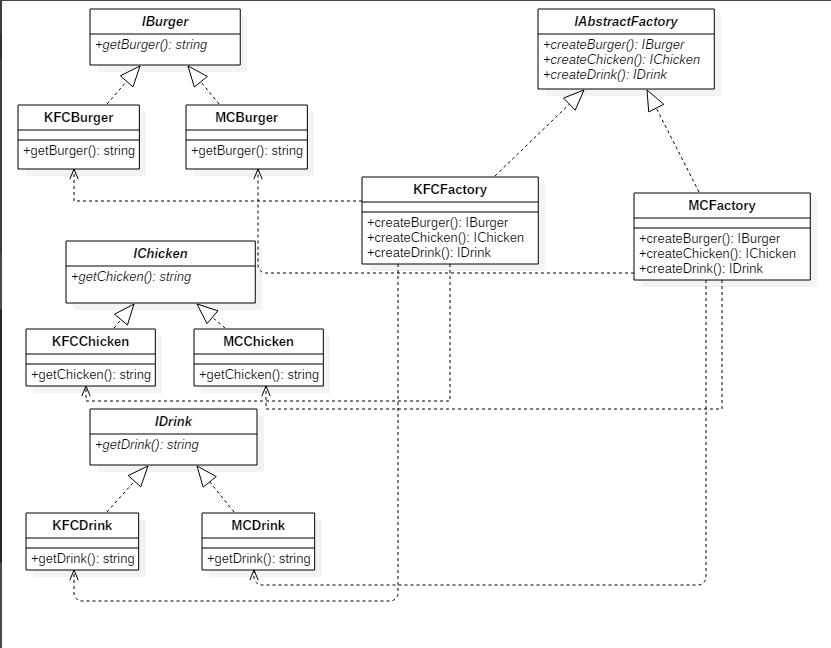Spring部分源码
先给出spring中常用的一段代码,典型的工厂模式:
import org.springframework.context.ApplicationContext;
import org.springframework.context.support.FileSystemXmlApplicationContext;
public class App {
public static void main(String[] args) {
ApplicationContext context = new FileSystemXmlApplicationContext(
"C:/work/IOC Containers/springframework.applicationcontext/src/main/resources/bean-factory-config.xml");
HelloApplicationContext obj = (HelloApplicationContext) context.getBean("helloApplicationContext");
obj.getMsg();
}
}在AbstractApplicationContext中,getBean方法实现如下:
@Override
public Object getBean(String name) throws BeansException {
assertBeanFactoryActive();
return getBeanFactory().getBean(name);
}继续跟踪代码进入,spring如何获取bean?
检测beanname是否存在,首先判断map中是否存在该bean,根据beanName-instance映射关系,如果没有,判断是否正在创建,查询另外一个map,如果既不存在也没有正在创建,判断earlySingleton map是否存在,如果也不存在,从map查找bean对应的ObjectFactory,如果factory不为空,getObject获取对象,放入earlySingletonObjects map中,同时factory map移除
/** Cache of singleton objects: bean name --> bean instance */
private final Map<String, Object> singletonObjects = new ConcurrentHashMap<String, Object>(256);/** Names of beans that are currently in creation */
private final Set<String> singletonsCurrentlyInCreation =
Collections.newSetFromMap(new ConcurrentHashMap<String, Boolean>(16));/** Cache of early singleton objects: bean name --> bean instance */
private final Map<String, Object> earlySingletonObjects = new HashMap<String, Object>(16);什么是earlySingleton?
注册依赖的bean代码:
/** Map between dependent bean names: bean name --> Set of dependent bean names */
private final Map<String, Set<String>> dependentBeanMap = new ConcurrentHashMap<String, Set<String>>(64);/**
* Register a dependent bean for the given bean,
* to be destroyed before the given bean is destroyed.
* @param beanName the name of the bean
* @param dependentBeanName the name of the dependent bean
*/
public void registerDependentBean(String beanName, String dependentBeanName) {
// A quick check for an existing entry upfront, avoiding synchronization...
String canonicalName = canonicalName(beanName);
Set<String> dependentBeans = this.dependentBeanMap.get(canonicalName);
if (dependentBeans != null && dependentBeans.contains(dependentBeanName)) {
return;
}
// No entry yet -> fully synchronized manipulation of the dependentBeans Set
synchronized (this.dependentBeanMap) {
dependentBeans = this.dependentBeanMap.get(canonicalName);
if (dependentBeans == null) {
dependentBeans = new LinkedHashSet<String>(8);
this.dependentBeanMap.put(canonicalName, dependentBeans);
}
dependentBeans.add(dependentBeanName);
}
synchronized (this.dependenciesForBeanMap) {
Set<String> dependenciesForBean = this.dependenciesForBeanMap.get(dependentBeanName);
if (dependenciesForBean == null) {
dependenciesForBean = new LinkedHashSet<String>(8);
this.dependenciesForBeanMap.put(dependentBeanName, dependenciesForBean);
}
dependenciesForBean.add(canonicalName);
}
} protected Object getSingleton(String beanName, boolean allowEarlyReference) {
Object singletonObject = this.singletonObjects.get(beanName);
if (singletonObject == null && isSingletonCurrentlyInCreation(beanName)) {
synchronized (this.singletonObjects) {
singletonObject = this.earlySingletonObjects.get(beanName);
if (singletonObject == null && allowEarlyReference) {
ObjectFactory<?> singletonFactory = this.singletonFactories.get(beanName);
if (singletonFactory != null) {
singletonObject = singletonFactory.getObject();
this.earlySingletonObjects.put(beanName, singletonObject);
this.singletonFactories.remove(beanName);
}
}
}
}
return (singletonObject != NULL_OBJECT ? singletonObject : null);
}
抽象工厂实例

参考:
https://www.cnblogs.com/134ylx/p/ylx_AbstractFactory.html

我的实例
抽象工厂横向扩张增加类型需要修改工厂类,但是纵向扩张容易。
应用界面:
但是我可以数据库配置银行以及信用卡,贷款之间的关系,根本不需要该代码。


